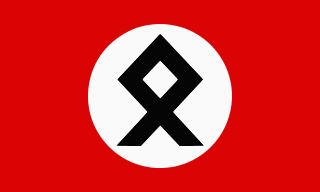
The Piazza Fontana bombing was a terrorist attack that occurred on 12 December 1969 when a bomb exploded at the headquarters of Banca Nazionale dell'Agricoltura in Piazza Fontana in Milan, Italy, killing 17 people and wounding 88. The same afternoon, another bomb exploded in a bank in Rome, and another was found unexploded in the Tomb of the Unknown Soldier. The attack was carried out by the Third Position, neo-fascist paramilitary terrorist group Ordine Nuovo and possibly certain undetermined collaborators.

Giuseppe Umberto "Pino" Rauti was an Italian fascist and politician who was a leading figure on the radical right for many years. Involved in active politics since 1948, he was one of founders and, for many years, the leader of the Italian Social Movement (MSI). He was the main representative of the MSI's “moderates”.

The National Vanguard is a name that has been used for at least two neo-fascist and neo-Nazi groups in Italy.
The National Front was a neo-fascist political party in Italy.

Giorgio Almirante was an Italian politician who founded the neo-fascist Italian Social Movement, which he led until his retirement in 1987.
Roi Zorzi, presently known as Roi Hagen (波元路伊), is an Italian-born Japanese neo-fascist.

Yves Guérin-Sérac, born Yves Guillou was a French anti-Communist Roman Catholic activist, former officer of the French army and veteran of the First Indochina War (1945–54), the Korean War (1950–53) and the Algerian War of Independence (1955–62). He was also a member of the elite troop of the 11ème Demi-Brigade Parachutiste de Choc, which worked with the SDECE, and a founding member of the Organisation armée secrète (OAS), a French terrorist group based in Spain which fought against Algerian independence in 1961-62. It was alleged that he was an instigator of the so-called strategy of tension in Italy, and the main organizer of the 1969 Piazza Fontana bombing.

The Piazza della Loggia bombing was a bombing that took place on the morning of 28 May 1974, in Brescia, Italy during an anti-fascist protest. The terrorist attack killed eight people and wounded 102. The bomb was placed inside a rubbish bin at the east end of the square. In 2015, a Court of appeal in Milan issued a final life sentence to Ordine Nuovo members Carlo Maria Maggi and Maurizio Tramonte for ordering the bombing, closing one of the longest-running cases on terrorism during Italy's years of lead.

Pietro Valpreda was an Italian anarchist, poet, dancer and novelist.

The Nuclei Armati Rivoluzionari, abbreviated NAR, was an Italian terrorist neo-fascist militant organization active during the Years of Lead from 1977 to November 1981. It committed over 100 murders in four years, and had planned to assassinate the politicians Francesco Cossiga, Gianfranco Fini and Adolfo Urso. The group maintained close links with the Banda della Magliana, a Rome-based criminal organization, which provided such logistical support as lodging, false papers, weapons, and bombs to the NAR. In November 1981, it was discovered that the NAR hid weapons in the basements of the Health Ministry. The first trial against them sentenced 53 people in May 1985 on charges of terrorist activities.

In Italy, the phrase Years of Lead refers to a period of political violence and social upheaval that lasted from the late 1960s until the late 1980s, marked by a wave of both far-left and far-right incidents of political terrorism and violent clashes.

Franco "Giorgio" Freda is one of the leading neo-Fascist intellectuals of the post-war Italian far-right. He founded a publishing house for neo-Nazi thought, and described himself as an admirer of Hitler. He was convicted but later acquitted for lack of evidence for involvement in the Piazza Fontana bombing. He founded the Fronte Nazionale, which was disbanded by the Italian government in 2000 when Freda and forty-eight other members were found guilty of attempting to re-establish the National Fascist Party.

Carlo Cicuttini was an Italian-born, naturalized Spaniard neofascist terrorist.
Secolo d'Italia is a daily online newspaper in Italy, published since 1952, formerly supporting neo-fascism. In 2012, it ceased its print edition and continued as an online-only conservative publication.

The Italian Social Movement was a neo-fascist political party in Italy. A far-right party, it presented itself until the 1990s as the defender of Italian fascism's legacy, and later moved towards national conservatism. In 1972, the Italian Democratic Party of Monarchist Unity was merged into the MSI and the party's official name was changed to Italian Social Movement – National Right.

The Ordine Nero was an Italian terrorist fascist group founded in 1974 following the dissolution of the fascist Ordine Nuovo. Between 1974 and 1978, bombings by ON led to a number of woundings and deaths, having orchestrated several deadly bombings and murders including the 1974 Italicus Express Bombing and the 1974 Brescia Bombing.
In the First Italian Republic, after the Second World War, many armed, paramilitary, far-right organizations were active, as well as far-left ones, especially in the Years of Lead.
Carlo Digilio, also known as Zio Otto, was an Italian terrorist, soldier, and self-styled secret agent. He belonged to the neo-fascist group Ordine Nuovo and later became a collaborator. At the end of the first-degree process, he was convicted for the Piazza Fontana bombing, but the reliefs of law extinguished his guilt. He was also involved in the Piazza della Loggia bombing.
Pierluigi Concutelli, known as The Commander, was an Italian neofascist, terrorist, and bank robber. He styled himself as an "urban guerrilla fighter". He was a member of the far-right organization Ordine Nuovo, and later became the leader of its underground armed unit, Gruppi di Azione Ordinovista.
Paolo Signorelli was an Italian author, activist, and politician of the extreme right.















